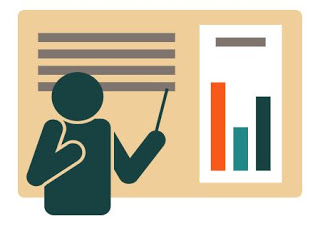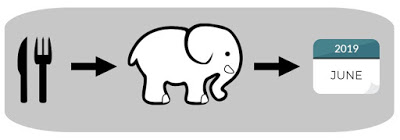What’s the best way to eat an elephant? One bite at a time. I believe the same holds true for any large-scale goal, for any organization.
Napkins and cutlery are on the table, ladies and gentlemen. I hope you brought your appetites.
If they were advising an organization on the best way to achieve this odd culinary goal, Covey, McChesney, and Huling might lay out something like this, using their 4 Disciplines of Execution (2012).
Discipline 1: Focus on the Wildly Important
In this case, the Wildly Important Goal (WIG) might seem obvious and self-explanatory–eat the elephant–but it still needs to be stated in a clear, measurable fashion. Covey et al. lay out some basic tenets for the WIG: it should begin with a verb, it should define the measurement of the goal as “X to Y by when,” and it should be simple. “Eat 100% of an elephant by June 2019.”
Discipline 2: Act on the Lead Measures
Examining “lag measures” tells you if you have achieved your goal–has the elephant been eaten, and on time? While accurate, they are reflective of things that have already happened–they aren’t proactive. “Lead measures,” on the other hand, are both predictive of achieving the goal and are influenceable by the team responsible for the goal. If everyone on the team eats a predetermined number of bites of the elephant every week, the team is likely to achieve the goal. This is a fairly obvious lead measure, but there could be others. For example, a lead measure that could clear the path toward helping each team member meet their weekly quota of bites might be, “Do a daily cleanup of the team break area to make sure snack foods are stored out of sight.” If other snacks aren’t readily available, team members are that much more inclined to have an extra bite of elephant.

Discipline 3: Keep a Compelling Scoreboard
People play differently when score is being kept, and when they can easily tell how well they are doing. I envision a large board with the outline of an elephant, with the outline being filled in slowly day by day as more and more bites are taken. Perhaps the elephant could even be divided into sections, one for each team member.
Underneath, I see a bar graph indicating how many times each team member has hidden away snack foods in the break area.
Discipline 4: Create a Cadence of Accountability
Covey et al. stress this discipline as possibly the key of the 4DX philosophy. The team meets on a regular basis (ideally once a week) for a short, focused WIG session in which members report on the prior week’s commitments, evaluate the current status of the scoreboard and discuss successes and failures, and make commitments for the coming week. In this way, team members maintain regular accountability to the goal and to each other, and are able to deal with challenges collaboratively and in a timely fashion. “My commitment last week was to pack up all cookies in the break room at 2 pm on Tuesday and Thursday. I did this. The scoreboard shows that last week I was 3 bites over my 20-bite quota for the week. This week I’m going to jog 2 miles before work on Monday and Wednesday in order to increase my appetite.”

*****
Let’s have a look at how the 4DX model might be implemented with my innovation plan.
Stage 1: Getting Clear
In Stage 1, the team establishes the details of the 4DX process: the WIG is established, lead measures are identified, a clear scoreboard is designed, and WIG sessions are scheduled. For my plan, the overall goal is to introduce the idea of the creative process (creation, feedback, revision) into classrooms in all disciplines. But it will be the team members–teachers who are introduced to this process by completing the online Technology-Assisted Music course–who will determine what the actual WIG will be in pursuit of this objective, and what the best measures will be. They may determine that the best way forward is to set a goal of delivering a set number of creative-process-centered lessons in their own classrooms over the course of the school year. Or they may determine that collaborating and sharing what they have learned with colleagues in their academic area may be more effective in reaching the maximum number of students, or that it’s more important to establish a foothold in a wide cross-section of academic disciplines. Whatever they choose, it is vital that the team have a great deal of voice in determining its goal–otherwise buy-in will be difficult, if not impossible.
Stage 2: Launch
This is the point where the rubber meets the proverbial road, and where, as in any space mission, most of the energy is expended. Plans can be easy to make in a meeting, but when the reality of trying to meet new expectations, keep up with new (and often difficult-to-track) lead measures, and maintain regular accountability with the team all run up against the daily whirlwind of life as a teacher, the different levels of buy-in and motivation among the team members will start to become readily apparent; models (immediate buy-in), potentials (initial strugglers), and resisters (little or no buy-in) will begin to emerge. It may turn out that teachers in typically “creative” subject areas are more willing or able to incorporate that process into their lessons than teachers in more “structured” areas. It may also be the exact opposite. Or it may be that the inclinations of the individual teacher are of far more impact than their academic discipline. As energy is focused on establishing and maintaining the 4DX process, all of these things will begin to become clear.
Stage 3: Adoption
For better or worse, this is the stage at which things begin to plateau, at least for a while. Routines are established, adjustments are made, and leaders begin dealing with both potentials and resisters, helping clear their paths toward more buy-in and to greater contribution toward meeting the team WIG (perhaps potentials who have begun to move into “model” territory can mentor resisters, much like the example, cited on page 43 of 2013’s Influencer, of the first-week Delancey Street residents who are placed in charge of even newer residents). At this stage, teachers may be getting a better sense of which lead measures are actually moving the scoreboard most significantly. This is the stage that likely takes the most time, and the stage at which focus on the 4DX process, more than results, is most important.
Stage 4: Optimization
At this stage, engagement among team members begins to noticeably increase. As the team begins to see results, they will begin generating their own ideas to improve their lead measures. (“If I exercise before work, I’ll be hungrier and can eat more elephant;” “If students have more opportunities to choose their areas of academic inquiry, they’re more likely to be doing creative work.”) It is vital at this point that contributions of ideas are recognized and successes are celebrated, especially as potentials and resisters start performing more and more as models.
Stage 5: Habits
This is really the end of one cycle and the beginning of another; as the achievement of one goal is celebrated (“We ate the elephant!” “Every academic department in this building has at least one teacher who incorporates at least one creative-process-based lesson per week!” ), the team prepares to leverage the habits and lessons learned toward the accomplishment of a new WIG. (“Every teacher in this building will incorporate at least one creative-process-based lesson per week;” “Let’s eat a WHALE!”)
*****
Having spent some time examining both the 4DX model and the Influencer model put forth by Grenny et al. (2013), especially as they relate to my innovation plan, I have a few thoughts.
Both models seem to focus on breaking down large tasks into discrete chunks. (What’s the best way to eat an elephant? One bite at a time.) I think this makes them both more manageable and less intimidating; the value is as much psychological as practical. And when it comes to getting organizational buy-in, the psychological factor can’t be underestimated.
The difference between the two models, I think, boils down to the question of strategy vs. tactics. The Influencer model, as the name suggests, leans more toward winning over the hearts and minds of the members of your organization. The 4DX model is a more detailed picture of what you do with those hearts and minds once you’ve won them over. I can picture a 4DX model of eradicating the Guinea worm:
I’m trying not to picture 6 sources of influence for eating an elephant….
REFERENCES
Covey, S., Huling, J., & McChesney, C. (2012). The 4 disciplines of execution. London: Simon & Schuster UK Ltd.
Grenny, J., Maxfield, D., McMillan, R., Patterson, K., & Switzler, A. (2013). Influencer: The new science of leading change (2nd ed.). New York, NY: McGraw Hill.








